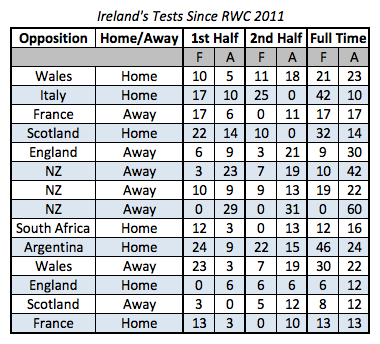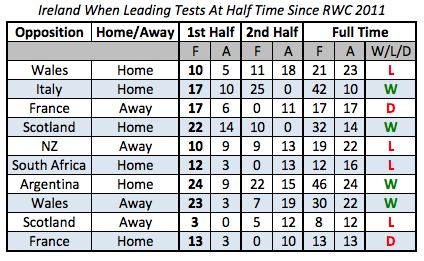Ireland’s Lost Leads
Ireland led France 13-3 at half time on Saturday only to go scoreless in the second half and finish with a 13-13 draw. At half time the crowd would have been generally much happier with the skill levels that Ireland showed in what were hugely difficult playing conditions – a squally rain gusted in over the top of the Aviva stadium for the entire match, growing worse in the second half. With a greasy ball Ireland’s execution was light years better than they had managed against England just two weeks beforehand, with good tactical kicking, sensible passing and mostly excellent handling.
The second half was a different matter with Ireland coming out fairly flat and allowing the French back into the game. Ireland were even the beneficiaries of a number of soft decisions by referee Steve Walsh, one scrum decision at midfield – awarding a wheel to Ireland when one might have rather thought that the French had driven straight through the Irish pack – notable for the understandably angry reaction it provoked from the many thousands of travelling French fans. Those fans would boo later in the game too, not at their side failing to achieve a thrilling comeback win in Dublin, but rather at their out-half, Freddie Michalak, kicking possession away when France had their tails up and Ireland were very obviously on the ropes.
Ireland being on the ropes in the second half of a rugby test match is something that has become a common sight in recent months. In the 14 tests Ireland have played since the 2011 Rugby World Cup, they have been leading at half time on ten occasions. That’s most certainly a positive. The problem for Ireland, and the grist to the mill for those seeking to unseat Declan Kidney, is they’ve managed to retain that lead at full time just four times.
Going back to the second test in New Zealand in summer 2012 where points-scoring is concerned only twice have Ireland raised their game in the second half – against England and Scotland in this year’s Six Nations. Looking at points scored only tells part of the story, obviously. Against Wales in 2013 Ireland scored so many points in the first half that it would have been extremely unlikely that they would score the same number again. They had almost managed it against Argentina in the previous test, scoring 24 points in the first and 22 in the second, but in Wales they managed just another seven in the second period. Equally, in those games against England and Scotland Ireland had managed zero and three points in the respective first halves.
The graph below shows the difference between Ireland’s points scored in the first and second halves of all tests played in 2012 and 2013 compared with what they’ve allowed the opposition to do. A positive value on either line means that Ireland have scored/allowed more points in the second half than they scored/allowed in the first half.
The pattern is fairly clear.
Leaping out to a strong lead then soaking up opposition pressure is a perfectly good recipe for winning rugby matches. Unfortunately, Ireland haven’t been very good at holding up the second half of that equation. Since last Autumn against South Africa, Argentina, Wales, Scotland and France, Ireland allowed their opponents to come back in the second half of every match but one. The lone exceptions, England, were already in the lead at half time and Ireland only managed a six-all draw in the second period.
There could be many factors in play here. For example, it’s fair to point out that Ireland have introduced younger players due to injury and perhaps they just don’t have the experience of “seeing out a game” that more wise old heads would do. Maybe some English-based writers might point to the lack of promotion or relegation in the Rabodirect Pro 12 and deduce that it breeds “softer” players than those of the battle-hardened Premiership or Top 14. Others might point to the number of injuries Ireland have endured and determine that the bench depth just isn’t there to have late game impact, or perhaps the depth is still there and isn’t being used properly.
The above are all possible causes; the only thing that is absolutely clear is that Ireland’s second half woes are very, very real and considering what Italy almost managed to do in their second half in Twickenham on Sunday combined with yet more Irish injuries, that could spell huge danger for Ireland in Rome.
As the cardinals prepare to be sealed into the Sistine Chapel to begin the papal conclave one must presume that Declan Kidney is feverishly working on a second half masterplan to face Italy on St. Patrick’s weekend.
And if he isn’t, he should be.
This article was also published as part of a Balls.ie Rugby Nerds piece.



